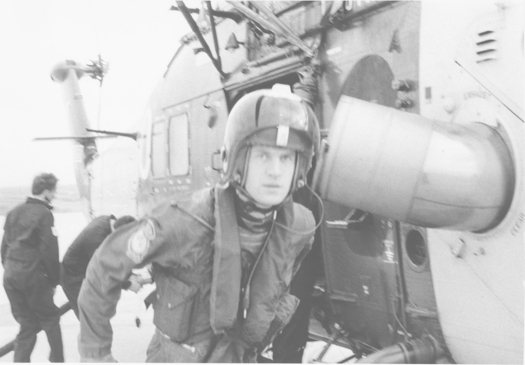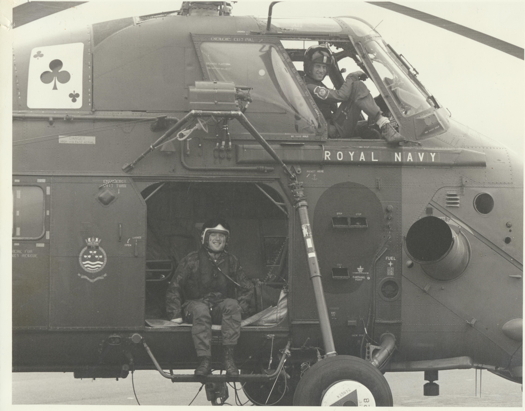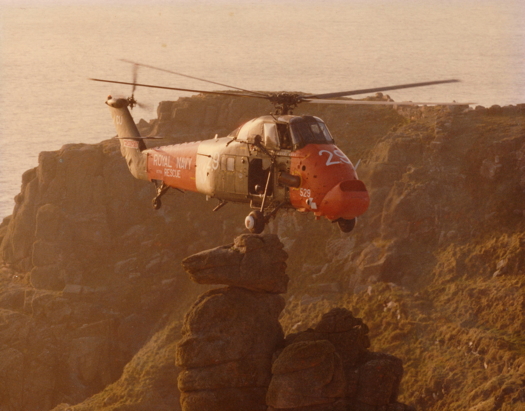
Jerry Grayson’s memoir about his experiences as a Royal Navy search-and-rescue pilot is now available for sale in the U.S. and Canada. Photo courtesy of Jerry Grayson
Jerry Grayson was the youngest pilot the Royal Navy had ever had when he joined the service at just 17 years old. During his time as a search-and-rescue (SAR) pilot, he was part of the response to the 1979 Fastnet yacht race disaster, when a terrible storm hit 303 yachts that were racing off the west coast of England, claiming the lives of 15 competitors. Grayson was awarded the Queen’s Commendation for Valuable Service in the Air for his part in the rescue, and at the end of his time in the Navy, received the Air Force Cross from the Queen at Buckingham Palace. After leaving the military, he embarked on a career as a film helicopter pilot. He has now written a book — Rescue Pilot: Cheating the Sea — about his experiences in the Royal Navy. The book was released in the United States and Canada on Sept. 29, 2015. (The first chapter can be read online for free here.)
Vertical: When did you decide you wanted to be a pilot?
Jerry Grayson: I’d always assumed I was going to fly; I never wanted to do anything else. I would even sit at the end of runways and listen to the VHF [radio] as they sequenced the airliners in. I got to the stage where I was sort of impatient to leave school and go flying. I passed all the aptitude stuff [at the Royal Navy], and they give me a flying scholarship, which paid for me to do my PPL [private pilot licence] while I was still at school.
V: Did you begin with search-and-rescue?
J.G.: My initial flying training was fixed-wing, and then we did helicopters — the Hiller UH-12E, and then [Westland] Whirlwind 7. Then there was a choice: you went [Westland WS-61] Sea King or [Westland] Wessex. Sea King was anti-submarine; Wessex was ‘Junglies,’ Commando. I went with the Sea King and ended up with anti-submarine, which was not what I really wanted to do.
I spent my first frontline tour on HMS Ark Royal, which was just fabulous. I still, to this day, say the flight deck of an aircraft carrier is the most exciting place on the earth — bar none. The antisubmarine flying was either monotonous — four and a half hours in the hover at night with a sonar buoy dangling in the water — or it was full-on, when you actually got contact with a submarine and you were chasing it. It was the time of the Cold War, so the Russians were quite serious about practicing trying to get underneath our carriers. The one time that our sonar operator whispered, ‘I’ve got a Russian contact,’ led to the most extraordinary hour that I had in a Sea King, which was going head to head with a Russian sub commander; he was throwing out all his decoys and all his tricks, and we were just trying to keep hold of him.
I did two tours in the Sea King, and during the second tour I just continually told everyone that I was going to fly search-and-rescue until they believed it — and I ended up getting appointed to Culdrose in the southwest of Cornwall. It was the most fabulous job. I just loved it.

For Grayson, the cooperation and teamwork involved in search-and-rescue was one of the most satisfying aspects of the job. Photo courtesy of Jerry Grayson
V: What was the appeal of search-and-rescue?
J.G.: I think two things: It was back to a single-pilot aircraft, as the Sea King was two pilots, and the autonomy — you really were a unit apart from everything else. We worked our own routine; we came in at about an hour before dawn, and worked until midday, or came in at midday and worked until dusk.
And the other side of it is in the military, you train for something you hope is never going to happen — in terms of warfare — but you secretly kind of hope that it might happen, and then you feel guilty about that. But in SAR, you’re using all the skills you learnt over the years to do something that’s worth doing. A good or bad day in the office for us was: “Did somebody live at the end of the day that might otherwise not have done?”
V: Was it everything you thought it was going to be?
J.G.: It was everything that I hoped it would be and more. The crew side of things was unbelievably satisfying. It was three people each with different skills, combining to achieve a worthwhile task where you were literally relying on each other for your lives; I couldn’t hover with my blades a couple of feet away from a cliff without my crewman that I really, really, trusted keeping me accurate. The diver relied on the crewman and me to put them in the right place and get them back out afterwards. We were totally interdependent. Your biggest fear was letting down your crewmates.
V: Your highest profile mission was the 1979 Fastnet yacht race — how did that day unfold?
J.G.: The forecast said it was going to be quite rough, but it was nothing like accurate. During the night, as the yachts were rounding the Fastnet Rock at the southern tip of Ireland, what had been forecast as something like a force 7 [on the Beaufort scale] got up to a force 12, and all of the yachts were hit by these extraordinarily high seas. According to the report afterwards, the average waves were 40 to 45 feet, and every three hours the highest wave was 85 to 90 feet. I did a BBC program last month when I was back in the U.K. about it with a chap called Nick Ward, who was the very last man to be picked up that day; the race organizer; and a couple of other yachtsmen. These guys who had been in the yacht said every single wave that came past looked to them like they were sailing towards a cliff. They rose vertically on it, went over the crest, and literally dived down vertically. At the bottom, instead of rolling, they’d do a thing called pitch-poling — which means the nose of your yacht goes straight into the water, and your yacht turns end over end. By the time we got out there they had all been doing this for about four or five hours. It was the most extraordinary sea state that I’ve ever seen before or since.

The power of the Westland Wessex proved valuable in demanding rescue missions, including the 1979 Fastnet yacht race. Photo courtesy of Jerry Grayson
V: How do you operate in those conditions?
J.G.: We were in the Wessex 5, which was a wonderful machine. It had a [Rolls-Royce] Gnome engine, which is the same as the Sea Kings have, but the aircraft was about half the weight — so it was very powerful.
We are talking about the days before GPS, and we didn’t have any radar, so navigation was the first difficulty. Then we had trouble finding anything — your eyes are better at finding things if they know what they’re looking for, and we couldn’t wrap our heads around what a yacht would look like in a sea state that high. And as each of these ginormous waves came rolling in, the wind — which was up at 60 or 70 knots at that stage — was blowing a horizontal line of white surf off the top, so a yacht in a trough was actually hidden from sight by this spray.
Once you had found a yacht, then obviously you’ve got to get down and hover next to it. The power of the Wessex allowed it to go up and over each wave. As the pilot, you keep your head very still, because you’re relying on the fluid in your ear canals to keep you stable and to be able to feel the movement of the helicopter. So I was looking out the starboard side of the aircraft, and effectively flying in formation with the yacht as it went up and down.
We had to ask people to jump into the water one at a time –because once a mast is flailing around from one side to the other, it’s going to swipe your diver very rapidly — and once you do that, you are very definitely taking their life into your hands, and you better be bloody sure you’re capable of getting them out. Once they were in the water, the yacht blew away from them very rapidly, and we were able to move in over the top and pick them up from our normal 15-foot hover height, albeit with 45-foot crests coming towards us.
V: How was the rescue response organized?
J.G.: It was chaos is the quick answer to that. We were just completely overwhelmed with mayday calls on the yachting frequency. It became a democratic thing of organizing ourselves — “I’ll take this, you take that,” then one found oneself flying over the top of something that wasn’t necessarily the target you’re going towards, but you’re not going to go past the target onto something else. The first job that I went to was a yacht called the Magic, and I had been on my way to something further north. We picked up five people from that, and then a further 10 people during the day. That was the second flight of a day that started at 4:30 a.m., and I eventually finished at about 4:30 p.m.
V: How did you get into film flying?
J.G.: After two tours on SAR, I came out of the Navy and started Castle Air. Cornwall is a very picturesque area, and film production companies would come down there to do commercials or bits and pieces for TV or for movies, and so we quite quickly got into doing film work. I absolutely loved it, because it was using the helicopter to do something else — you aren’t just going from A to B, you’re using your skills to move the camera around, so you get to fly in a very creative way. After 10 years running Castle Air, I left and started my own company, Helifilms, and we concentrated purely on film flying.
V: What do you think of the change to civilian-provided SAR in the UK?
J.G.: It’s fascinating, isn’t it? Actually, I think it’s not a bad thing at all. The reality is that when I was flying the Wessex, they had finished time on frontline Commando work. SAR always got the machines after they had finished frontline work. And now, with the civilian contract, they’re all brand new machines, and they’re all designed for the job. And the reality is that most of the aircrew are ex-military anyway. The other side of that coin is that as a military pilot, generally whatever it takes to get the job done is what you do, whereas the civilians are very definitely under CAA [Civil Aviation Authority] auspices. I think only time will tell.
This interview has been edited and condensed, and originally appeared in the June-July 2015 issue of Vertical.









